Measuring water fluorescence
Unlike apparent characteristics of water, such as its colour and transparency, fluorescence is not usually visible by eye when looking at the sea or a lake. This is due to the weakness of the signal, when compared to the green backscattered light. To make fluorescence visible we have to reach into our bag of tricks.
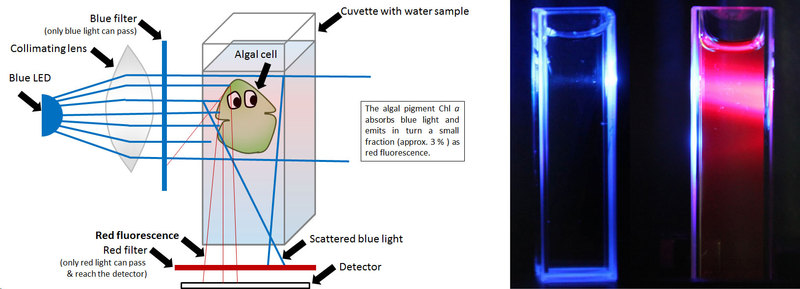
Figure 1. Image on the left: Fluorescence can be measured directly in the water, or in a transparent measurement container- a cuvette. In the shown case, a white LED with all colours of the spectrum is used to activate red fluorescence in pigments of microscopic algae in such a cuvette. The light is concentrated to a strong beam through the sample by a collimating convex lens, but then only the blue fraction of light is allowed to pass a filter. It is then absorbed by the pigments in the algal cell and a weak signal is emitted as red fluorescence. (images: coursey of Anna Friedrichs)
Image on the right: When blue light shines on pure water in a cuvette, the light is scattered back from the container´s wall. When the same light is sent through a cuvette filled with a solution of highly concentrated algal chlorophyll a, the blue light is absorbed by the pigments and red fluorescence dominates the image. (images: coursey of Julia A. Busch & Anna Friedrichs)
Basically, a light source for excitation, as well as a detector is needed for fluorescence measurements (see Figure 1). The detector can be a photomultiplier – a highly sensitive light detector- or a CCD chip (Charge-Coupled Device) as in digital cameras. For measuring water fluorescence directly in the water, a waterproof housing must protect the electronic parts of the instrument. Water samples can also be measured on land in a small cuvette- a transparent container (see Figure 1).
Fluorescence is measured in relative units. The intensity of the signal is then set in relation to the intensity of the light which was used to induce it. This relative fluorescence signal can then be calibrated to the concentration of water constituents. The higher the concentration, the higher is the fluorescence signal. 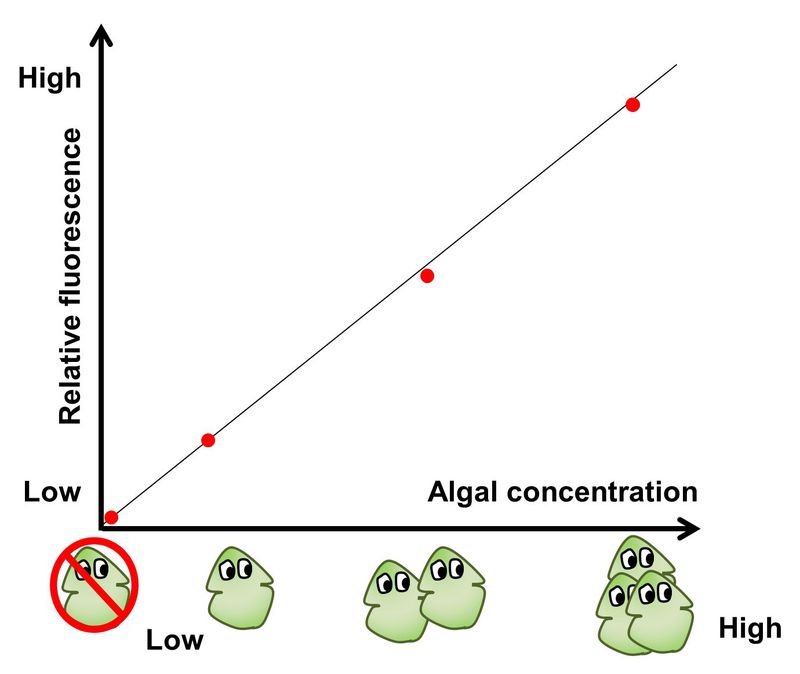
Figure 2. The higher the concentration of algal cells, the stronger gets the relative red fluorescence of a water sample. The known concentration of algae in a sample can be set in relation to the relative fluorescence signal. With this relation, also unknown algal concentrations in field samples can be calculated from the fluorescence signal. (image: courtsey of Julia A. Busch)
Transform your smart phone to a fluorescence sensor
1) Proof-of-principle
Within the project Citclops, we have tested internal smart phone components for their use to excite and to detect fluorescence (flashlight and camera). While the blue fraction of the smartphone´s flashlight did not allow the use for fluorescence excitation, the smart phone camera proved to be sensitive as fluorescence detector, and we developed an algorithm to convert the simple RGB images (red-green-blue) to algal fluorescence (RGB2Chl Algorithm).
To overcome limitations of the flashlight at blue wavelengths, we used an external blue LED for fluorescence excitation. This external LED, electronics, and a 9V battery were integrated to a plastic housing, which we tailored to fit on a Samsung Siii mini smartphone. The housing also contains room for a cuvette and a filter holder (Friedrichs et al., 2014, 2015a, 2015b) Figure 3). This adapter converts a simple smart phone to a fluorescence sensor (SmartFluo).
In principle, blue light from the external LED passes the cuvette with the water sample and excites red fluorescence of algal cells in the sample. This red fraction of light is then passed through an affordable red plastic filter to the smart phone camera. The red filter prevents that only red fluoresced light passes through to the camera. Sensor geometry within the adapter ensures that the excitation and detection are aligned in 90 degree to each other, to further minimise that excitation light reaches the detector.
How a real measurement with the SmartFluo is conducted is explained in a step-by-step instruction and also demonstrated in a video (Friedrichs et al., in prep.).
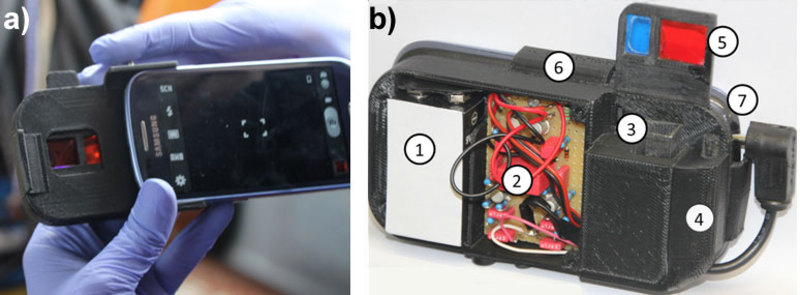
Figure 3: SmartFluo a) Attachable adapter for fluorescence measurements by means of smart phones. The external LED can be triggered by an external switch (shown here) or by an App. b) the adapter is constructed of a 3-D printed housing with a (1) 9V battery block, (2) control unit for the external LED, (3) room for a cuvette for the water sample, (4) external LED (hidden), (5) an adjustable filter holder, (6) holder system to attach to a smart phone, (7) possibility to operate electronics and external LED via the earphone plugin (images courtesy A. Friedrichs).
Data received with SmartFluo are evaluated by means of the RGB2Chl algorithm. With the intensity of the RGB´s red channel and the illumination time of an image, fluorescence intensity is calculated. This can then be set in relation to Chl a concentration (Friedrichs, et al., in prep).
The adapter proved to be robust in the field and we conducted several measurements during Citclops citizen science events e.g. Sea kayak symposium in April 2015, Spain; Blue Info Days in April 2015, Ireland; and Ocean Sampling Day 2015, Germany; and during a research cruise from Germany to Norway along the coast in July 2015 (Figure 4).
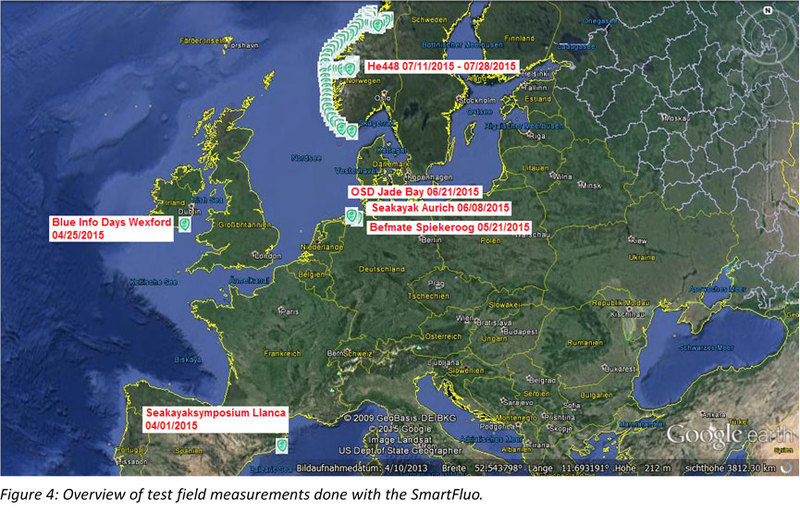
2) How to build the adapter?
Within the project period, we successfully proofed that algal fluorescence can be retrieved by means of smart phones and the adapter.
If you are interested to build your own adapter please contact us at the Institute for Chemistry and Biology of the Marine Environment of the Carl von Ossietzky University Oldenburg. To build the adapter for a Samsung Siii mini smart phone, you need a 3-D printed housing , and the instruction how to build the adapter , including a control unit for the external LED. The method is certainly adoptable to other smart phone types, so please feel free to tailor it for your device. Please let us know how you proceed. We are happy to support you!
We are continuing to work on proper quality control, higher sensitivity and transferability of the method. If you would like to stay up to date on our progress, please let us know (Prof. Dr. O. Zielinski ).
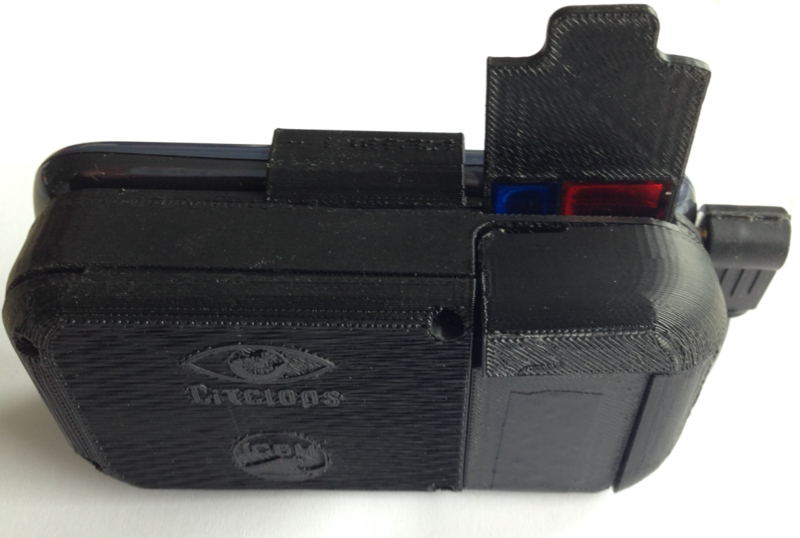
Figure 5: SmartFluo fluorescence adapter to measure algal fluorescence in a water sample with smart phones.
References
Friedrichs Anna; Julia A. Busch; Rohan H. Henkel; Rüdiger Heuermann; Christopher John; and Oliver Zielinski, “Measuring fluorescence by means of smartphones with the new Citclops Application”, Ocean Optics XXII, 2014
Friedrichs Anna; Julia A. Busch; Hans J. van der Woerd; Christopher John; and Oliver Zielinski, “Measuring fluorescence by means of smart phones with the new Citclops-application”, ASLO Aquatic Science Meeting, 2015a
Friedrichs Anna; Julia A. Busch; Christopher John, Hans J. van der Woerd, Oliver Zielinski, “The way from a smart phone to an affordable fluorescence sensor for phytoplankton retrieval”, 4th EOS Topical Meeting on Blue Photonics® – Optics in the Sea (Blue Photonics 4), 2015b
Friedrichs Anna; Julia A. Busch; Christopher John; Hans J. van der Woerd; and Oliver Zielinski, in manuscript, “Measuring chlorophyll a fluorescence in water by means of smart phones” (in prep. for Limnology Oceanography: Methods)
